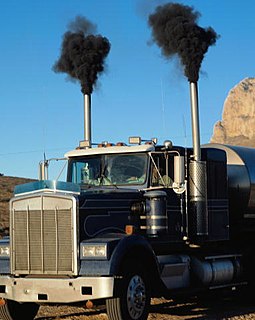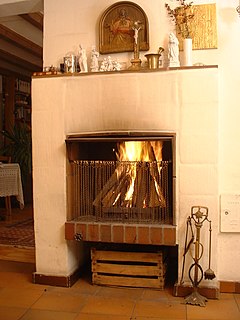Standard specifications
Escape hoods that are certified to ANSI/ISEA 110 will provide the specified level of protection to escape from the byproducts of fire including particulate matter, carbon monoxide, other toxic gases and the effects of radiant heat. [2]
To earn certification, the escape hood must meet specified requirements for physical characteristics. [3] Escape hoods are tested for donning, optical properties, corrosion resistance and proving the operational packaging does not leak. During the certification process random samples are conditioned by exposure to vibration, puncture and tear, and extremes of pressure and temperature. Dynamic performance requirements including a carbon dioxide check, breathing resistance, particulate filtration and total inward leakage as a measure of overall performance. Specific tests are made to prove resistance to defined thermal threats including inhalation temperature, soot particulate, flammability, molten polymeric drip resistance and radiant heat resistance. The devices are tested with a series of chemical gases, including: carbon monoxide, hydrogen cyanide, sulfur dioxide, hydrogen chloride, acrolein, and cyclohexane. These gases include those that are toxic byproducts of combustion and those that are effective indicators of performance against an entire class of gases.

Smoke is a collection of airborne particulates and gases emitted when a material undergoes combustion or pyrolysis, together with the quantity of air that is entrained or otherwise mixed into the mass. It is commonly an unwanted by-product of fires, but may also be used for pest control (fumigation), communication, defensive and offensive capabilities in the military, cooking, or smoking. It is used in rituals where incense, sage, or resin is burned to produce a smell for spiritual or magical purposes. It can also be a flavoring agent and preservative.

Indoor air quality (IAQ) is the air quality within and around buildings and structures. IAQ is known to affect the health, comfort, and well-being of building occupants. Poor indoor air quality has been linked to sick building syndrome, reduced productivity, and impaired learning in schools.

A smoke detector is a device that senses smoke, typically as an indicator of fire. Commercial smoke detectors issue a signal to a fire alarm control panel as part of a fire alarm system. Household smoke detectors, also known as smoke alarms, generally issue an audible or visual alarm from the detector itself or several detectors if there are multiple devices interlinked.

A breathing gas is a mixture of gaseous chemical elements and compounds used for respiration. Air is the most common, and only natural, breathing gas. But other mixtures of gases, or pure oxygen, are also used in breathing equipment and enclosed habitats such as scuba equipment, surface supplied diving equipment, recompression chambers, high-altitude mountaineering, high-flying aircraft, submarines, space suits, spacecraft, medical life support and first aid equipment, and anaesthetic machines.

Exhaust gas or flue gas is emitted as a result of the combustion of fuels such as natural gas, gasoline (petrol), diesel fuel, fuel oil, biodiesel blends, or coal. According to the type of engine, it is discharged into the atmosphere through an exhaust pipe, flue gas stack, or propelling nozzle. It often disperses downwind in a pattern called an exhaust plume.

A fireplace or hearth is a structure made of brick, stone or metal designed to contain a fire. Fireplaces are used for the relaxing ambiance they create and for heating a room. Modern fireplaces vary in heat efficiency, depending on the design.

A respirator is a device designed to protect the wearer from inhaling hazardous atmospheres, including fumes, vapours, gases and particulate matter such as dusts and airborne microorganisms. There are two main categories: the air-purifying respirator, in which respirable air is obtained by filtering a contaminated atmosphere, and the air-supplied respirator, in which an alternate supply of breathable air is delivered. Within each category, different techniques are employed to reduce or eliminate noxious airborne contaminants.

An air purifier or air cleaner is a device which removes contaminants from the air in a room to improve indoor air quality. These devices are commonly marketed as being beneficial to allergy sufferers and asthmatics, and at reducing or eliminating second-hand tobacco smoke.

A fog machine, fog generator, or smoke machine is a device that emits a dense vapor that appears similar to fog or smoke. This artificial fog is most commonly used in professional entertainment applications, but smaller, more affordable fog machines are becoming common for personal use. Fog machines can also be found in use in a variety of industrial, training, and some military applications. Typically, fog is created by vaporizing proprietary water and glycol-based or glycerin-based fluids or through the atomization of mineral oil. This fluid vaporizes or atomizes inside the fog machine. Upon exiting the fog machine and mixing with cooler outside air the vapor condenses, resulting in a thick visible fog.

A smoke hood is a hood wherein a transparent airtight bag seals around the head of the wearer while an air filter held in the mouth connects to the outside atmosphere and is used to breathe. Smoke hoods are intended to protect victims of fire from the effects of smoke inhalation. A smoke hood is a predecessor to the gas mask. The first modern smoke hood design was by Garrett Morgan and patented in 1912.

The nine-volt battery, or 9-volt battery, is a common size of battery that was introduced for early transistor radios. It has a rectangular prism shape with rounded edges and a polarized snap connector at the top. This type is commonly used in smoke detectors, gas detectors, clocks, walkie-talkies, electric guitars and effects units.

A carbon monoxide detector or CO detector is a device that detects the presence of the carbon monoxide (CO) gas to prevent carbon monoxide poisoning. In the late 1990s Underwriters Laboratories changed the definition of a single station CO detector with a sound device to carbon monoxide (CO) alarm. This applies to all CO safety alarms that meet UL 2034 standard; however for passive indicators and system devices that meet UL 2075, UL refers to these as carbon monoxide detectors.
The Air Movement and Control Association International, Inc. (AMCA) is a long-established American trade body that sets standards for Heating, Ventilation and Air Conditioning (HVAC) equipment. It is best known for its ratings in fan balance and vibration, aerodynamic performance, air density, speed and efficiency.

Theatrical smoke and fog, also known as special effect smoke, fog or haze, is a category of atmospheric effects used in the entertainment industry. The use of fogs can be found throughout motion picture and television productions, live theatre, concerts, at nightclubs and raves, amusement and theme parks and even in video arcades and similar venues. These atmospheric effects are used for creating special effects, to make lighting and lighting effects visible, and to create a specific sense of mood or atmosphere. If beams of light are visible cutting across a room, that most likely means smoke or fog is being used. Theatrical smoke and fog are indispensable in creating visible mid-air laser effects to entertain audiences. Recently smaller, cheaper fog machines have become available to the general public, and fog effects are becoming more common in residential applications, from small house parties to Halloween and Christmas.
A gas detector is a device that detects the presence of gases in an area, often as part of a safety system. A gas detector can sound an alarm to operators in the area where the leak is occurring, giving them the opportunity to leave. This type of device is important because there are many gases that can be harmful to organic life, such as humans or animals.
Inhalation is a major route of exposure that occurs when an individual breathes in polluted air which enters the respiratory tract. Identification of the pollutant uptake by the respiratory system can determine how the resulting exposure contributes to the dose. In this way, the mechanism of pollutant uptake by the respiratory system can be used to predict potential health impacts within the human population.
Home safety refers to the awareness and education of risks and potential dangers in and around a home which may cause bodily harm, injury, or even death to those residing in and around the physical structure of a home. It includes mitigating or preventing unwanted dangers through testing, research, and accepted standards of applications and practices.
The Uniform Mechanical Code (UMC) is a model code developed by the International Association of Plumbing and Mechanical Officials (IAPMO) to govern the installation, inspection and maintenance of HVAC and refrigeration systems. It is designated as an American National Standard.

A respirator cartridge or canister is a type of filter that removes gases, volatile organic compounds (VOCs), and other vapours from breathing air through adsorption, absorption, or chemisorption. It is one of two basic types of filters used by air-purifying respirators.The other is a mechanical filter, which removes only particulates. Hybrid filters combine the two.
Workplace exposure monitoring is the monitoring of substances in a workplace that are chemical or biological hazards. It is performed in the context of workplace exposure assessment and risk assessment. Exposure monitoring analyzes hazardous substances in the air or on surfaces of a workplace, and is complementary to biomonitoring, which instead analyzes toxicants or their effects within workers.












